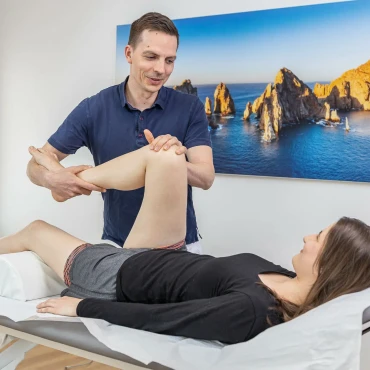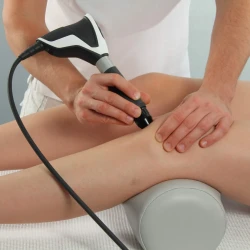Patellar tendinopathy - irritation of the patellar tendon
The patellar tendon connects the thigh muscle to the tibia via the kneecap (patella). Its primary task is to transfer force from the thigh to the lower leg. It is therefore strained with every movement of the knee joint.
If the patellar tendon is permanently overloaded, chronic knee pain develops. If the irritation of the patellar tendon at the tip of the patella, i.e. at the lower part of the kneecap, is in the foreground, this is referred to as patella tip syndrome; if the irritation of the patellar tendon at the other end, i.e. at the attachment to the tibial tuberosity (tibial tuberosity), is in the foreground, this is referred to as distal patellar tendon irritation or, in adolescents, Osgood-Schlatter's disease (see below).
The causes of knee joint complaints can be numerous. The most common is so-called functional knee pain, which is caused by muscular complaints,
irritation of the capsule-ligament apparatus or tendon irritation such as pesanserinus syndrome or patellar tendinopathy. People who are particularly active in sports have an increased risk of knee injuries. Among the most common are meniscus tears and cruciate ligament tears - often caused by an accident. However, chronic overloading, which results in joint wear and tear (osteoarthritis), can also be the cause of pain. There are also a number of other diseases that cause pain in the knee joint. An early and accurate diagnosis by an experienced orthopaedic surgeon is always necessary in order to be able to initiate the best individual treatment with the aim of relieving or alleviating pain.
A distinction must be made between acute and chronic pain in the knee. Acute pain occurs suddenly and is usually triggered by an accident or trauma.
Therapy for patellar tendinopathy
The therapy modules recommended by the orthopaedic surgeon for Jumpers Knee depend on the extent of the symptoms and the stage of the disease, among other things. The respective therapy modules are always developed individually after a detailed medical history and examination and discussed together with the patient.
Combination of focussed shock wave therapy (ESWT) of the tendon and radial shock wave therapy of the thigh muscles.
Fascia and trigger point treatment of the entire chain from the lumbar spine to the arch of the foot.
Manual-therapeutic - osteopathic treatment of the pelvic-leg chain
Regenerative injection or hyaluronic acid
Acupuncture can be used to reduce pain and inflammation.
Kinesiotaping of the knee joint and patellar tendon complements orthopaedic treatment techniques, especially for muscular complaints and sports injuries.


Book a consultation appointment now!
A quick, simple and easy way to your appointment.
Patellar tendinopathy
Who is most commonly affected by patellar tendinopathy?
Tendinopathies are also a common cause of functional knee pain. This refers to tendon irritation, usually caused by overloading, e.g. of the patellar tendon (patellar tendon) or the adductor muscles (pes anserinus).
The patellar tendon is the connection between the thigh muscle and the kneecap (patella). Patellar tendinopathy is also known as "jumpers knee", as the condition often occurs in athletes who play sports that involve a lot of jumping. However, it can also affect people who do not play any sport or other sports. Patellar tendinopathy is caused by unusual strain on the knee or the patellar tendon.
Pes anserinus refers to a tendon that is formed by the tendons of three muscles on the inside of the thigh and is located in a common tendon in the centre front area of the tibial plateau slightly below the knee joint space. Pes anserinus syndrome occurs when there is inflammation in this tendon and its bony insertion. This condition, which is easily confused with a meniscus problem, is often caused by imbalances, overloading, strains or chronic tension in this muscle group. Typical symptoms are pain on the inside of the knee joint, often accompanied by tenderness to the touch. Painful tension or active trigger points in the adductor muscles, which cause pain to radiate into the pes anserinus, are also a common cause of pain. There may be a connection here with pelvic obliquity, which can be caused by a blockage of the sacroiliac joint (SIJ). A thorough examination and diagnosis by an orthopaedic surgeon will determine the individual cause of the pain and treat it accordingly (see below).
What are the symptoms of patellar tendinopathy?
In the early stages of patellar tendinopathy, there is often initially pain in the area of the patellar tendon, which occurs during or after exertion such as jogging, climbing stairs or walking downhill. If the condition progresses untreated, those affected often also suffer from pain at rest. This considerably reduces their quality of life. Athletes may have to take long breaks from training and competitions or even give up sport.
Early diagnosis by an orthopaedic surgeon and individual treatment of the irritation of the patellar tendon are crucial for the successful healing of patellar tendonitis.
As soon as there are symptoms that suggest patellar tendinopathy, an experienced orthopaedic surgeon should be consulted to assess whether it is actually a case of jumper's knee or whether another condition is causing the knee pain. A thorough medical history and examination by the orthopaedic surgeon is of the utmost importance. Imaging procedures such as sonography (ultrasound) and, if necessary, magnetic resonance imaging (MRI) are also used to assess the state of irritation or possible degenerative changes in the patellar tendon.
Once the diagnosis of patellar tendinopathy has been confirmed, the first step is to immediately and drastically reduce the load. The orthopaedist will then initiate targeted conservative treatment of the patellar tendon, the primary aim of which is to allow the irritated patellar tendon to regenerate naturally, heal the micro-injuries to the tendon and achieve freedom from symptoms.
An independent exercise programme is a central therapeutic component in the treatment of irritation of the patellar tendon.
As part of successful treatment, a coordinated training programme that the patient carries out independently at home is important in order to improve the load-bearing capacity of the patellar tendon and its attachment. This programme combines isometric training in the first few weeks with eccentric training in the following weeks and months. You can find specific instructions for this exercise programme here.
Irritation of the patellar tendon in children and adolescents
Patellar tendon complaints do not only occur in adults. Children and adolescents can also be affected. It is usually triggered by too much or too quickly increased strain, which overstrains the patellar tendon interfaces, which are still growing. The problem is therefore often found in children and adolescents who are active in sports.
The patellar tendon in young patients is typically painful at two locations.
If the tendon insertion in the upper area of the kneecap is affected (proximal patellar tendon), as with patellar tendinopathy, it is often a case of Sinding-Larsen-Johansson disease - also known as Sinding-Larsen disease. Characteristic symptoms are localised pain at the tip of the kneecap, which can occur during and after sporting activity. Prolonged, unusual or excessive tensile stress on the patellar tendon can cause tears in the tendon fibres, resulting in inflammation in the tendon and at the tendon insertion. Sports that involve a lot of jumping, quick changes of direction or stopping movements such as high jump or long jump, football, basketball or volleyball harbour a particularly high risk.
If the symptoms are localised at the lower end of the patellar tendon (distal patellar tendon) at the attachment point of the tibial tuberosity (tuberositas tibiae), the orthopaedist refers to this as Osgood-Schlatter disease. Typical symptoms are pain and swelling below the patellar tendon, which increases during sporting activity, decreases after a break, but increases again when the joint is loaded again. In addition to jumping or running, knee pain can also be triggered by prolonged bending (e.g. at school, on the bus/train or at the cinema).
Both Sinding-Larsen syndrome and Osgood-Schlatter syndrome are benign conditions that the orthopaedic surgeon can diagnose with certainty by taking a thorough medical history and performing a clinical examination, supplemented by ultrasound scans if necessary. Both have a good prognosis and are the domain of conservative treatment. Treatment is very similar to that for patellar tendinopathy in adults.
If you have knee pain or questions about patellar tendonitis or irritation of the patellar tendon in children and adolescents, we at Orthopassion will be happy to help you personally as specialised orthopaedic specialists. Please do not hesitate to contact us or book an appointment directly in the online booking system.

